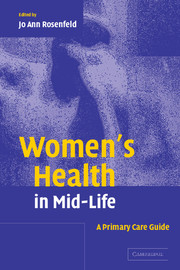Book contents
- Frontmatter
- Contents
- List of contributors
- 1 Introduction
- Part I Health promotion
- Part II Hormonal changes
- 8 Physical changes in menopause and perimenopause
- 9 Spiritual and psychological aspects of menopause
- 10 Hormone therapy
- 11 Contraception and fertility
- Part III Disease prevention
- Part IV Cancer prevention
- Index
- References
8 - Physical changes in menopause and perimenopause
from Part II - Hormonal changes
Published online by Cambridge University Press: 21 August 2009
- Frontmatter
- Contents
- List of contributors
- 1 Introduction
- Part I Health promotion
- Part II Hormonal changes
- 8 Physical changes in menopause and perimenopause
- 9 Spiritual and psychological aspects of menopause
- 10 Hormone therapy
- 11 Contraception and fertility
- Part III Disease prevention
- Part IV Cancer prevention
- Index
- References
Summary
Case: S. J. is a 47-year-old woman who presents with abnormal uterine bleeding. She had regular periods until two years ago, at which time her periods became unpredictable. Her current menses started three weeks ago; she says it alternates between needing to change pads hourly to requiring only a daily panty liner. Ms J. is obese and smokes a pack of cigarettes a day. Her only medication is thyroid supplements. Her obstetrical history is gravida three para two spontaneous abortion one (G3P2 AB 1). She uses condoms intermittently for contraception, and her first pregnancy was at age 29.
Perimenopause and menopause
Perimenopause is the time in a woman's life when she begins to experience the changes that lead to menopause. The World Health Organization (WHO) defines this as a “period immediately prior to menopause (when the endocrinological, biological, and clinical features of approaching menopause commence) and the first year after menopause.”1
This transition is caused by a decrease in gonadotropin and ovarian hormones. The ovaries produce decreasing amounts of estrogen and the target organs become less sensitive. Some women experience significant symptomatology during this time, which leads them to seek medical assistance. Menstrual changes, hot flushes, and other signs of estrogen deficiency, such as vaginal dryness, may be the first symptoms that a woman experiences. Perimenopause is a transition phase that usually lasts four to six years. This is the time when women move from a state of fertility and potential childbearing to infertility and permanent amenorrhea.
Keywords
- Type
- Chapter
- Information
- Women's Health in Mid-LifeA Primary Care Guide, pp. 125 - 136Publisher: Cambridge University PressPrint publication year: 2004
References
- 2
- Cited by



